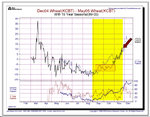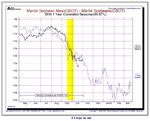Yesterdays trades (5th Dec) - all MOC
I closed out my remaining LH position (April -Feb) - B1 Feb LH @ 64.55 S1 April LH @ 67.70 close spread 3.15
I opened one live cattle spread June - August B1 M LC @ 87.45 S1 Q LC @ 86.15 open spread 1.3
I tried to open the June - December LH spread but my broker advised that the Dec contract was very illiquid. I cancelled the trade but am unsure how much of a problem this might be. If it's just a few cents in one leg of a trade that might last two months then I don't see a problem.
Could anyone elaborate on the possible problems?
Thanks
FN
I closed out my remaining LH position (April -Feb) - B1 Feb LH @ 64.55 S1 April LH @ 67.70 close spread 3.15
I opened one live cattle spread June - August B1 M LC @ 87.45 S1 Q LC @ 86.15 open spread 1.3
I tried to open the June - December LH spread but my broker advised that the Dec contract was very illiquid. I cancelled the trade but am unsure how much of a problem this might be. If it's just a few cents in one leg of a trade that might last two months then I don't see a problem.
Could anyone elaborate on the possible problems?
Thanks
FN








